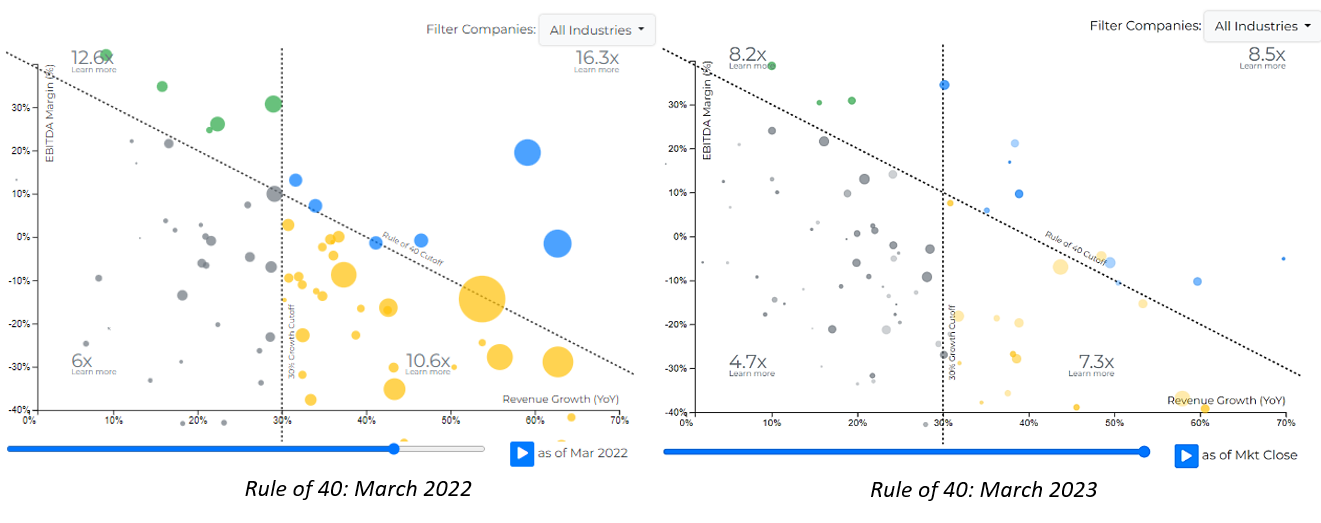This piece is authored by Dave Gordon, Principal at Volition Capital.
Introduction
In April 2022, we shared our perspective on Exceptions to the Rule of 40. Now that we’re wrapping up April 2023, we thought it would be a good time to revisit the Rule of 40 and share some of our current thoughts on the metric.
As a reminder, the Rule of 40 is simply calculated by adding your revenue growth rate with profitability margin. If the sum of these two figures is above 40, you fulfill the Rule of 40.
For a macro analysis on how the Rule of 40 changed over this past year, make sure to check out this great piece by my colleague Pete Keenan, CPA.
Takeaways
1. Structural Issues
While the Rule of 40 can be a useful metric for assessing a company’s performance, it may not provide a complete picture of the business. The Rule of 40 isolates two inputs without considering other aspects of the business including forward looking estimates which are critical for a holistic view of a company.
Additionally, the decision to pursue growth versus profitability is typically based on strategic goals and initiatives set at the board level. The Board’s recommendation to prioritize investing in growth or optimizing the business for profitability can vary year to year, be impacted by the availability of capital, or the company’s business lifecycle.
One specific component to the Rule of 40 that we have been thinking about lately is the fact that revenue growth and profitability margin have equal weight in the equation. Due to the fact that revenue growth is a year-to-year metric, a strong 2022 could lead to a difficult year-to-year comparison for 2023. At the same time, EBITDA margin is a moment-in-time metric without intrinsic annual comps and overall sees less volatility – hence, highlighting a structural issue of equal weight between revenue and EBITDA margin.
This principle is exemplified when looking at Bill.com, the leader of the Rule of 40 Index in March 2022 with a score of 149. This score was fueled by 190% revenue growth and leveled down by a -49% EBITDA margin. However, as of March 2023, Bill.com dropped to 21st on the list with a Rule of 40 score of 32 (66% revenue growth and -34% EBITDA margins).
Although the company had strong EBITDA margin improvements of ~1,500 basis points, revenue growth of only 66% was not enough to fulfill the Rule of 40. 66% growth is incredibly strong, especially after a year that saw 190% growth on a $642 million base (Bill.com 2022 revenue). However, the Rule of 40 does not take into account prior year success or the revenue base they are growing off of.
2. Blend Labs
If you were to look at the Rule of 40 Index from March 2022, the company with the second highest Rule of 40 score was Blend Labs with a score of 91 (164% revenue growth and -73% EBITDA margin). Fast forward to today? Blend Labs is last.
What happened?
Blend Labs is a FinTech company that is focused on creating back-end infrastructure for banking products. In Q4, Blend had a 48% decrease in Q4 year-over-year revenue from ~$81 million to ~$43 million. Why?
Blend has two key areas of business exposure: consumer banking and mortgage/real estate banking. Consumer banking displayed strong growth of 100%, however, the mortgage banking segment was hit hard as the real estate market slowed down greatly. Specifically, in regard to mortgage banking, this line of business decreased 48% year-over-year from $29 million to $15 million.
Additionally, in March 2021, Blend acquired Title365, a title insurance and settlement services company, in hopes of continuing to build out their goal of owning every step of the home purchasing life cycle. However, with the collapse of the mortgage market, Title 365 revenue decreased from $44 million to $13 million, representing a 70% decrease year over year.
The example of Blend reiterates that the Rule of 40 is just a snapshot of a moment in time and does not give insights into the makeup of the revenue, its quality, or long-term sustainability.
Blend has a lot of work to do and likely needs the real estate transaction market to return to normalcy to start climbing back up the rankings.
3. The Landscape
If you were to talk to Wall Street analysts and ask which SaaS companies held up the best over the past year, they would likely say the ones that had strong profitability profiles. Why? As interest rates started rising, the narrative on the street changed from prioritizing growth to profitability on the stop of a dime.
However, when taking a closer look in the SaaS space, this does not necessarily appear to be the case. Check out these two charts below, the first from March 2022 and second from March 2023:

If you were to compare the high growth companies on this list (the right half of the chart) you will see that the top right quadrant, companies with higher growth, actually saw their median valuation multiple drop by around 50% while high growth companies with negative profit margins by around 30%.
Interestingly, when looking at low growth companies (the left side of the graph), companies with a lower profitability profile actually saw less of a decrease in valuation over the year of ~20% while higher EBITDA margin companies saw ~35% drop.
There is the narrative, and then there is the reality. And when it comes to SaaS, the narrative does not always support the reality.
Further support of this lack of prioritization of profitability in SaaS can be seen when you look at the two highest valued SaaS companies as of March 2023: Snowflake and Cloudflare.
Snowflake and Cloudflare, both had negative EBITDA margins of -37% and -5% respectively. At the same time, they traded at 16.8x sales and 16.5x each. In other words, a high multiple, but not profitable.
Therefore, when it comes to SaaS, even in these uncertain times, it appears that Wall Street is still valuing quality above all else, albeit, at lower multiples.
Conclusion
In this update, we took a critical look at the Rule of 40, and further highlighted that it is a valuable resource, however, reminding us all it is important to recognize the metric represents a moment in time and a limited snapshot.
I look forward to connecting with all of you again soon. If you would like to chat more about the Rule of 40, the venture landscape, or how Volition can be a resource to you, feel free to shoot me an email at dave@volitioncapital.com
Talk soon.
-Dave
Want to stay up to date on everything Volition? Make sure to subscribe to our newsletter using the button below!
